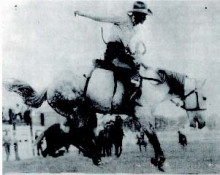 History shows only a half-dozen western artists who actually lived and worked as cowboys during the open-range era of the West. Cowboy artist, inventor and rodeo champion Earl W. Bascom was the last of this rare breed.
History shows only a half-dozen western artists who actually lived and worked as cowboys during the open-range era of the West. Cowboy artist, inventor and rodeo champion Earl W. Bascom was the last of this rare breed.
Earl’s life started in a sod-roofed log cabin on the 101 Ranch near Vernal, Utah on June 19, 1906. When Earl was 6-years-old, his mother, Rachel Lybbert Bascom, died of cancer, leaving five small children, the youngest only nine months old. After his wife’s death, John Bascom decided to leave Utah and move his family to Canada.
The Bascom family arrived at the newly settled Alberta town of Raymond, not far from the U.S border. The town of Raymond was named after the millionaire rancher, Ray Knight. Knight had large ranch holdings, totaling nearly a million acres, the largest being the Kirkaldy on the Milk River Ridge, pasturing hundreds of horses, some 18,000 head of cattle and several thousand sheep. Ray hired Earl’s father as a ranch foreman. Many of Earl’s cowboy experiences took place on the rolling hills of the Knight ranch.
“There were two things Ray Knight loved,” Earl once recalled, “horses and rodeos.” Ray Knight became known as the “Father of Canadian Rodeo” when he promoted and produced Canada’s first rodeo, the Raymond Stampede, in 1902.It was there at the Raymond Stampede in 1918 that Earl entered his first professional rodeo.
“Ray Knight used to like to see us ride his big broncs. The higher they threw us the wider he grinned,” Earl reported. Ray had told the boys that they could practice on any bronc he had on the ranch. “On one roundup,” Earl once recalled, “we gathered 1,200 head of horses and bucked them out.”

“One thing that helped me in my rodeo career,” Earl said, “was some advice that an old time bronc rider, Walt Whitney, gave me. He said that if you want to succeed in rodeo don’t ever smoke or drink. He was at a rodeo once and the night before the Finals, he stayed up all night partying with the boys. The next day Walt didn’t buck off, he said he just went to sleep and fell off. And Walt was a champion bronc rider. I admired his abilities and took his advice.”
Earl rodeoed professionally for 23 seasons and traveled the rodeo circuit with his three brothers, Raymond (nicknamed Tom after Tom Mix), Mel and Weldon. Sometimes they traveled with the Lybbert brothers or the Lund brothers.
As an internationally acclaimed bronc rider and one of the top all-around cowboys, Earl reigned supreme in the arena from 1930 to 1940, but it was his and his family’s inventions that changed rodeo forever. The Bascom brothers, Raymond, Melvin and Earl designed and constructed the first known side-delivery rodeo chute at Welling, Alberta in 1916. In 1919 at Lethbridge, Alberta, the Bascom boys built a rodeo arena and redesigned their side-delivery chute so that it hinged at the horse’s head, forcing the horse to turn as the gate opened. The chute only required one man to work the gate and eliminated the hazard of banged-up knees. This Bascom design is now the standard for rodeo chutes.
Earl Bascom invented two important pieces of rodeo equipment, the first hornless bronc saddle back in 1922, (called the Mulee) first used at the Cardston Stampede, and the first one-handed bareback rigging in 1924, first used at the Raymond Stampede. Today, both are standard equipment at all professional rodeos throughout the world. In 1926, Earl designed rodeo chaps featuring a high-cut leg. Pete Knight borrowed them to have a pair made and the style became known as the “Pete Knight Chaps,” a forerunner to today’s rodeo chaps.
Throughout his life, Earl’s artistry was developing, culminating in masterful bronze sculptures held in thirty-six museums including every important Western museum collection such as the National Cowboy & Western Heritage Museum, Buffalo Bill Historical Center, Frederic Remington Museum of Art, Dallas Museum of Fine Art, Canadian Rodeo Hall of Fame and the Will Rogers Memorial Center. His hometown of Raymond is also a proud possessor of his art in the Raymond Museum and the Sports Hall of Fame. For his talents and achievements, Earl Bascom was listed in Who’s Who in American Art, Who’s Who in Western Writers of America, Who’s Who in the West, Who’s Who in California, Who’s Who in America and Who’s Who in the World.
Earl Bascom received countless honours during his lifetime, including induction into four Hall of Fames. His rodeo and cowboy experiences are written into permanent history in the Congressional Record in Washington, D.C., and President Ronald Reagan sent Earl a personal congratulation on the occasion of his last Hall of Fame induction. Earl Bascom passed away on August 28, 1995 the last of a rare breed – the Cowboy of Cowboy Artists.
